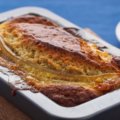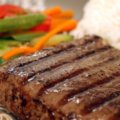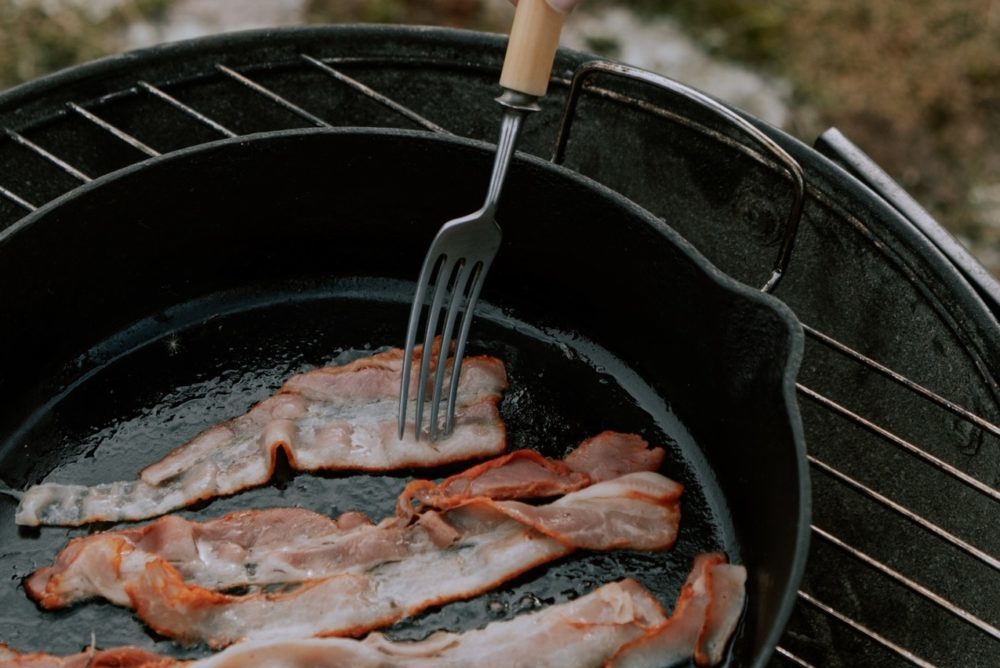It doesn’t matter if you are looking to upgrade your existing cookware or buy new pans. There are so many names and types of pans in cookware, you wonder which is best for you.
The most common dilemma you may face when buying a frying pan is wondering what to buy: a frying pan or skillet. You may wonder: what is the difference between frying pan and skillet?

Difference Between Frying Pan And Skillet
The dilemma arises because both seem similar in so many ways because both:
- Accommodate shallow frying
- Have slightly sloped sides
- Can grill steaks or scrambled eggs
- Are available in various materials like cast iron and stainless steel
- Are available with non-stick cooking surfaces
- Don’t have lids
With so many similarities, you wonder what the difference is and why there is so much confusion between them. Sometimes, it looks like the name is the only difference.
In short: skillets are often made of cast iron and therefore can be used in ovens or on a campfire. They are also slightly cheaper than most frying pans.
While the two terms are interchangeable, they should be referred to by their rightful term.
- Non-stick cookware is more likely called a frying pan than a skillet. Similarly, you don’t usually say ‘cast-iron frying pans.’ It is more commonly called a cast-iron skillet.
- And what about sauté pans, which are visibly different from shallow frying pans. They may seem similar to skillets but have a lid, flat bottom, straight sides, and are taller than skillets.
- Frying pans hold more liquids than skillets, making them ideal for cooking sauces that cover tender meat cuts. While they prevent spills, cooking access is limited, which may affect your cooking.
- Like frying pans, sauté pans also come with a long handle. However, they also have an additional, shorter handle on the opposite side to help you lift the pan after cooking. Their lids retain moisture, which is necessary while you slowly cook sauces for instance.
Now that you know how sauté pans are different from frying pans, we will provide you with a clear definition of frying pans and skillets. We have included their advantages, disadvantages, and answers to some commonly asked questions.
Frying Pan
A frying pan is a standard kitchen vessel used for frying and sautéing food. It comprises a long handle with wide, sloped edges and comes in different materials like stainless steel, cast-iron and non-stick.
The best investment would be in a heavy-duty, try-clad, or multi-clad stainless steel frying pan. Though expensive, they offer a lifetime of use.
Advantages
Frying pans are a great addition to any kitchen for the following benefits:
1. Speed
The reduced thickness and wide design evenly spread food across the pan to cook it quickly and evenly.
2. Flavor
As dishes cook faster, the flavor remains sealed and doesn’t escape.
3. Scratch-resistant
Most frying pans are of high-grade aluminum or stainless steel and naturally scratch-resistant. It means you can cook with metal utensils, without worrying about them ruining the cooking surface.
4. Versatility
The smooth and sloped edge of frying pans provides extra room and added versatility in cooking.
5. Needs less oil
If you choose a non-stick frying pan, you cook healthier dishes using less oil in the cooking process.
Disadvantages
Frying pans also have their share of disadvantages like:
1. Needs your attention
You can’t walk away while cooking because the cooking is quick. Cook with your full attention to avoid overcooking and ruining dishes.
2. Food easily burns
Cooking at high temperatures increases the risk of burned food because the food is more spread out than in cast-iron skillets.
3. Uneven cooking
Stainless steel frying pans are poor heat conductors, which lowers their cooking performance. You have to be more aware while cooking, to make sure your food gets cooked evenly.
Skillets
Skillets are similar to frying pans but with slightly taller edges. They are usually heavy-duty pans made of cast iron, safe to use on the stovetop, oven, or even campfires.
They may also be made of aluminum with a non-stick or ceramic coating or stainless steel. It’s better to season your skillet because food tends to stick to skillets that aren’t pre-seasoned.
Advantages
1. Retains heat
Cast iron retains heat well, letting you serve food in it without having to wait for it to cool down.
2. Safe in ovens
You can safely use cast iron skillets in ovens. It means there is no need to transfer the food to a baking dish. Just place the skillet into the oven as required. Read more in this article: Can A Cast Iron Skillet Go In The Oven
3. Increases iron content in food
Cast iron skillets can help your body meet your everyday iron requirements because iron enters the food and your body.
4. Do not stick and zero food contamination risks
If seasoned beforehand, cast iron skillets work like cookware with non-stick coatings. And as there are no synthetic non-stick coatings, it is non-toxic with zero risks of food contamination.
5. Some come with lids
Some skillets come with a lid to use for braising curries and thick sauces.
6. Affordably priced
Not many know that most skillets are cheaper than most types of frying pans.
Disadvantages
Of course, skillets have their share of disadvantages too.
1. Handle heats up
Iron skillets come from a single iron piece. However, as iron conducts heat, you risk burning yourself while handling the heated skillet handle while cooking.
2. Heavy
Cast iron skillets are rather heavy when compared to other cookware. Whether you can bear the weight is a factor to consider, especially if you use them extensively.
3. Rust
Cast iron skillets can get rusty. All it takes is a single drop of water to form rust in your stored skillets.
FAQ About Difference Between Frying Pan And Skillet
Here are answers to some frequently asked questions about differences between the frying pan and skillet.
Can You Use a Frying Pan As a Skillet?
Yes, you can use skillets and frying pans interchangeably for grilling, roasting, stewing, frying, and braising food.
What Kind of Pan Is a Skillet?
A skillet is a frying pan and a versatile piece of cookware with a flat bottom and curved sides. They come in various sizes, typically without a lid.
Why Is It Called a Skillet?
According to experts, the word ‘skillet’ comes from the Middle French word “esculette,” meaning “a little dish,” and the Latin word “scutella” meaning “serving platter.”
What Can You Cook In a Skillet?
As it is a versatile piece of cookware, you can cook multiple dishes in a skillet.
You can use it for cooking eggs, burgers, pancakes, pan pizza, tortillas, fried chicken, oatmeal, lasagna, sauté vegetables, pan-fry steaks, and even to reduce sauces.
What Can You Not Cook In a Cast-Iron Skillet?
There are a few things you should avoid cooking in a cast-iron skillet like:
- Acidic foods because the acid loosens metal molecules and these leach into your food. Acids also break down the seasoning of your skillet. Do not cook acidic foods like tomato sauces for more than a few minutes. Do not even let acidic foods sit in the pan for a while after cooking.
- Making desserts in the same cast-iron skillet you use for everyday cooking. Buy a separate skillet for desserts because the pan’s porous surface takes on flavors, and spoils the taste of your desserts.
- Cooking delicate fish like flounder or tilapia may stick and not flip well. Even the skin of heartier fish like salmon can stick to the surface, making flipping difficult. It’s better to cook your fish in stainless-steel pans.
- Cooking sticky food like pancakes, scrambled eggs, and fried rice for at least the first few months. Cooking more steaks and bacon enhances the coating with its fats so that the skillet can eventually handle sticky foods.
Can You Put Butter In a Cast-Iron Skillet?
Yes, but you have to use it properly. You cannot use butter or olive oil to initially season the skillet. However, you can use it for cooking as long as you mix it with equal amounts of mild vegetable oils. It helps reduce the burning of butter solids.
Do Eggs Stick To Cast Iron?
Yes, eggs do stick to cast iron skillets that are not properly seasoned or heated. It is because eggs contain heat-sensitive proteins that unfold react with the stove heat while you scramble or fry eggs.
They cook best on smooth-surfaced cookware because those surfaces do not react with the egg proteins.
However, cast iron skillets have dents, nicks, and cracks, which the egg protein bonds with and sticks to. The indentations also cook the egg white and yolk unevenly, resulting in sticking.
Do You Clean Cast Iron After Every Use?
This depends. Some people don’t wash their pans every time. They just wipe them out after each use so that the pan develops such a nice patina; you can even fry eggs in it.
However, it is also okay to clean your pan thoroughly using water and soap after each use. Do not use any metal scrubbers but use an ordinary kitchen sponge instead. Read more on how to clean a frying pan.
Do not let the pan stay wet, as even a drop of water in a stored pan can lead to rust. Yes, it is possible to remove the rust with scrubbing and reseasoning. But if you have an old pan you have not used for some time, you will have to season it until you think it is ready.
How Often Do You Season Cast Iron Pans?
It varies based on how you use and care for the pan. Most people season a new pan once or twice.
But if you have an old pan you have not used for some time you will have to season it until you think it is ready. All you have to do is add a little oil to the pan after each use. It gets seasoned and builds a better coating with time and usage. Read more on how to season a stainless steel pan and how to season an aluminum pan.
Conclusion
While looking at the difference between frying pan and skillet, there is not much difference between the two. It boils down to personal choice and your cooking style.
If you use various pans for different cooking purposes like cooking eggs and delicate fish, you could afford to buy a cast-iron skillet. However, if you are looking for something for everyday cooking, you should consider investing in a frying pan. Check out our Best Of articles which include both frying pans and skillets and find out what works for you:






